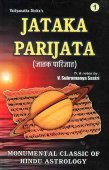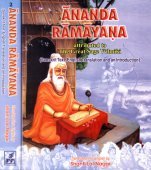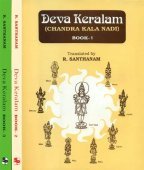Parijata, Pārijātā, Pārījāta, Pārijāta, Parijāta: 27 definitions
Introduction:
Parijata means something in Buddhism, Pali, Hinduism, Sanskrit, the history of ancient India, Marathi, Hindi, biology. If you want to know the exact meaning, history, etymology or English translation of this term then check out the descriptions on this page. Add your comment or reference to a book if you want to contribute to this summary article.
Alternative spellings of this word include Parijat.
In Hinduism
Natyashastra (theatrics and dramaturgy)
Source: archive.org: The mirror of gesture (abhinaya-darpana)One of the Hands indicating Trees.—Pārijāta, the Trijñāna hand, i.e., Patāka with both hands twisted upwards.

Natyashastra (नाट्यशास्त्र, nāṭyaśāstra) refers to both the ancient Indian tradition (shastra) of performing arts, (natya—theatrics, drama, dance, music), as well as the name of a Sanskrit work dealing with these subjects. It also teaches the rules for composing Dramatic plays (nataka), construction and performance of Theater, and Poetic works (kavya).
Ayurveda (science of life)
Source: Google Books: Essentials of AyurvedaPārijāta (पारिजात).—The Sanskrit name for an important Ayurvedic drug combination.—It is also known as Śephālī. Its beautiful flowers blossom in autumn season particularly navarātra (the nine days of the bright fortnight of Āśvina month when the worship of the goddess Durgā is celebrated). The juice of leaves is bitter and is specifically effective in sciatica and also in chronic fevers and intestinal worms
Source: Advances in Zoology and Botany: Ethnomedicinal List of Plants Treating Fever in Ahmednagar District of Maharashtra, IndiaPārijāta in the Marathi language refers to the medicinal tree “Nyctanthes arbor-tristis L.”, and is used for ethnomedicine treatment of Fever in Ahmednagar district, India. The parts used are: “Leaves”. Instructions for using the tree named Pārijāta: 10 ml of fresh juice from the boiled leaves with honey—twice a day.

Āyurveda (आयुर्वेद, ayurveda) is a branch of Indian science dealing with medicine, herbalism, taxology, anatomy, surgery, alchemy and related topics. Traditional practice of Āyurveda in ancient India dates back to at least the first millenium BC. Literature is commonly written in Sanskrit using various poetic metres.
Vaishnavism (Vaishava dharma)
Source: ISKCON Press: GlossaryPārijāta (पारिजात).—An extraordinarily fragrant white flower that Lord Kṛṣṇa brought from the heavenly planets for His wife Rukmiṇi.
Source: Pure Bhakti: Brhad BhagavatamrtamPārijāta (पारिजात) refers to:—A fragrant flower from heaven. (cf. Glossary page from Śrī Bṛhad-bhāgavatāmṛta).

Vaishnava (वैष्णव, vaiṣṇava) or vaishnavism (vaiṣṇavism) represents a tradition of Hinduism worshipping Vishnu as the supreme Lord. Similar to the Shaktism and Shaivism traditions, Vaishnavism also developed as an individual movement, famous for its exposition of the dashavatara (‘ten avatars of Vishnu’).
Purana and Itihasa (epic history)
Source: archive.org: Puranic Encyclopedia1) Pārijāta (पारिजात).—The sage who came to the court of Maya along with Nārada. (Chapter 5, Sabhā Parva).
2) Pārījāta (पारीजात).—See under Kalpavṛkṣa.
3) Pārijāta (पारिजात).—A serpent born in the family of Airāvata. This serpent was burnt to death at the Sarpasatra of Janamejaya. (Śloka 11, Chapter 51, Ādi Parva).
Source: archive.org: Shiva Purana - English TranslationPārijāta (पारिजात) is the name of a Gaṇanāyaka (“leader of Gaṇas”), according to the Śivapurāṇa 2.3.40 (“The Marriage Procession of Śiva”).—Accordingly, as Brahmā narrated to Nārada: “[...] The lord of Gaṇas, Śaṅkhakarṇa started with a crore of Gaṇas to the city of Himavat along with Śiva. Kekarākṣa took ten crores of Gaṇas with gaiety. Vikṛta, the leader of Gaṇas, took eight crores of Gaṇas. Viśākha took four crores and Pārijāta took nine crores of Gaṇas. The glorious Sarvāntaka and Vikṛtānana took sixty crores. Dundubha took eight crores. [...]”.
Source: Cologne Digital Sanskrit Dictionaries: The Purana Index1a) Pārijāta (पारिजात).—A heavenly plant; Satyabhāmā saw it in Indra's Nandana and asked Kṛṣṇa to take it home; Kṛṣṇa refused as it was once taken from the milk-ocean and by the consent of the gods given to Indra and to remove it was to face a war with him; still Satyabhāmā persisted and Kṛṣṇa yielding to her placed it on the Garuḍa; took it to the earth against Indra's will and placed it in Satybhāmā's garden; the watchmen objected and reported to Indra; war about the Pārijāta between the Gods and Kṛṣṇa; a compromise to be returned after Kṛṣṇa's decease;1 rejoiced by Dvārakā ci{??}izens.2 The tree in Śivaloka, that came out of the churning of the ocean.3
- 1) Bhāgavata-purāṇa III. 15. 19; IV. 6. 14; 30. 32; VIII. 11. 10; X. 37. 16, 68. 35; 59. 39-40; [65 (v) 21-36], [37-51]; 66 (v); [67 (v) 1-16, 26], [34,] [45,]; Ib. X. 68. 35. Viṣṇu-purāṇa V. 30. 32, 80; 38. 7.
- 2) Ib. V. 31. 1-11; 35. 25:
- 3) Brahmāṇḍa-purāṇa III. 32. 6; IV. 9. 70; Vāyu-purāṇa 106. 74; Viṣṇu-purāṇa I. 9. 95.
1b) A monkey chief and son of Śveta.*
- * Brahmāṇḍa-purāṇa III. 7. 181 236.
1c) (pariyatra) a mountain west of the Śitoda.*
- * Vāyu-purāṇa 36. 29; 42. 54.

The Purana (पुराण, purāṇas) refers to Sanskrit literature preserving ancient India’s vast cultural history, including historical legends, religious ceremonies, various arts and sciences. The eighteen mahapuranas total over 400,000 shlokas (metrical couplets) and date to at least several centuries BCE.
In Buddhism
Tibetan Buddhism (Vajrayana or tantric Buddhism)
Source: academia.edu: The Structure and Meanings of the Heruka MaṇḍalaPārijāta (पारिजात) refers to one of the eight trees (vṛkṣa) of the Kāyacakra, according to the 10th century Ḍākārṇava chapter 15. Accordingly, the kāyacakra refers to one of the four divisions of the nirmāṇa-puṭa (‘emanation layer’), situated in the Herukamaṇḍala. Pārijāta is associated with the charnel ground (śmaśāna) named Khaṇḍita and with the hell-guardian (narakapāla) named Pārijātā.

Tibetan Buddhism includes schools such as Nyingma, Kadampa, Kagyu and Gelug. Their primary canon of literature is divided in two broad categories: The Kangyur, which consists of Buddha’s words, and the Tengyur, which includes commentaries from various sources. Esotericism and tantra techniques (vajrayāna) are collected indepently.
India history and geography
Source: Shodhganga: Cultural history as g leaned from kathasaritsagaraParijata is the name of a tree mentioned in the Kathasaritsagara by Somadeva (10th century A.D).—Parijata is a tree famous for its delicate and fragrant flowers. A thicket of Parijata trees is mentioned.
Somadeva mentions many rich forests, gardens, various trees (e.g., Parijata), creepers medicinal and flowering plants and fruit-bearing trees in the Kathasaritsagara. Travel through the thick, high, impregnable and extensive Vindhya forest is a typical feature of many travel-stories. Somadeva’s writing more or less reflects the life of the people of Northern India during the 11th century. His Kathasaritsagara (‘ocean of streams of story’), mentioning Parijata, is a famous Sanskrit epic story revolving around prince Naravahanadatta and his quest to become the emperor of the vidyadharas (celestial beings).

The history of India traces the identification of countries, villages, towns and other regions of India, as well as mythology, zoology, royal dynasties, rulers, tribes, local festivities and traditions and regional languages. Ancient India enjoyed religious freedom and encourages the path of Dharma, a concept common to Buddhism, Hinduism, and Jainism.
Biology (plants and animals)
Source: Google Books: CRC World Dictionary (Regional names)1) Parijata in India is the name of a plant defined with Cochlospermum religiosum in various botanical sources. This page contains potential references in Ayurveda, modern medicine, and other folk traditions or local practices It has the synonym Wittelsbachia gossypium Mart. & Zucc., nom. illeg. (among others).
2) Parijata is also identified with Erythrina variegata It has the synonym Gelala litorea Rumph. (etc.).
3) Parijata is also identified with Nyctanthes arbor-tristis It has the synonym Parilium arbor-tristis Gaertn. (etc.).
4) Parijata is also identified with Zanthoxylum budrunga It has the synonym Zanthoxylum budrunga DC..
Example references for further research on medicinal uses or toxicity (see latin names for full list):
· Fitoterapia (2001)
· Species Plantarum (1753)
· An Interpretation of Rumphius’s Herbarium Amboinense (1917)
· Flora (1853)
· An Introduction to the Natural System of Botany (1836)
· Nova Genera ac Species Plantarum (Martius) (1824)
If you are looking for specific details regarding Parijata, for example health benefits, diet and recipes, side effects, extract dosage, pregnancy safety, chemical composition, have a look at these references.

This sections includes definitions from the five kingdoms of living things: Animals, Plants, Fungi, Protists and Monera. It will include both the official binomial nomenclature (scientific names usually in Latin) as well as regional spellings and variants.
Languages of India and abroad
Pali-English dictionary
Source: Sutta: The Pali Text Society's Pali-English DictionaryPārijāta, =pāricchattaka, VvA. 174. (Page 454)

Pali is the language of the Tipiṭaka, which is the sacred canon of Theravāda Buddhism and contains much of the Buddha’s speech. Closeley related to Sanskrit, both languages are used interchangeably between religions.
Marathi-English dictionary
Source: DDSA: The Molesworth Marathi and English Dictionarypārijāta (पारिजात).—m S pārijātaka m S The coral-tree, Erythrina fulgens.
Source: DDSA: The Aryabhusan school dictionary, Marathi-Englishpārijāta (पारिजात).—m pārijātaka m The coral-tree.
Marathi is an Indo-European language having over 70 million native speakers people in (predominantly) Maharashtra India. Marathi, like many other Indo-Aryan languages, evolved from early forms of Prakrit, which itself is a subset of Sanskrit, one of the most ancient languages of the world.
Sanskrit dictionary
Source: DDSA: The practical Sanskrit-English dictionaryPārijāta (पारिजात).—[pāramasyāstīti pārī samudrastatra jātaḥ, tasya samudrotpannatvāt]
1) Name of one of the five trees of Paradise, Nictanthus arbor-tristis (said to have been produced at the churning of the ocean and come into the possession of Indra, from whom it was wrested by Kṛṣṇa and planted in the garden of his beloved Satyabhāmā), कल्पद्रुमाणामिव पारिजातः (kalpadrumāṇāmiva pārijātaḥ) R.6.6;1.11;17.7; पञ्चैते देवतरवो मन्दारः पारिजातकः (pañcaite devataravo mandāraḥ pārijātakaḥ) Ak.
2) The coral tree.
3) Fragrance.
Derivable forms: pārijātaḥ (पारिजातः).
See also (synonyms): pārijātaka.
Source: Cologne Digital Sanskrit Dictionaries: Edgerton Buddhist Hybrid Sanskrit DictionaryParijāta (परिजात).—[, in °tāni puṣpāṇi Mahāvastu iii.99.19, = Sanskrit pāri°, a (heavenly) flower; not in Senart's Index, hence no doubt merely an uncorrected misprint for Sanskrit pāri°.]
Source: Cologne Digital Sanskrit Dictionaries: Shabda-Sagara Sanskrit-English DictionaryPārijāta (पारिजात).—m.
(-taḥ) 1. Name of one of the five trees of paradise supposed to have been produced at the churning of the ocean. 2. The coral tree, (Erythrina fulgens.) E. pāri said to mean, above, and jāta produced.
Source: Cologne Digital Sanskrit Dictionaries: Benfey Sanskrit-English DictionaryPārijāta (पारिजात).—i. e. pari-jāta (vb. jan), + a, m. 1. A tree of paradise, [Harivaṃśa, (ed. Calc.)] 7168. 2. The coral tree, Erythrina indica Lam. 3. A proper name.
Source: Cologne Digital Sanskrit Dictionaries: Cappeller Sanskrit-English DictionaryPārijāta (पारिजात).—[masculine] the coral tree, [Name] of one of the five trees of paradise, a man’s name.
Source: Cologne Digital Sanskrit Dictionaries: Aufrecht Catalogus Catalogorum1) Pārijāta (पारिजात) as mentioned in Aufrecht’s Catalogus Catalogorum:—in dharma, see Āhnika, Dāna, Prayoga, Prāyaścitta, Madana, Vidhāna, Śānti.
2) Pārijāta (पारिजात):—nāṭaka, by Kumāratātaya. Burnell. 169^a.
3) Pārijāta (पारिजात):—[tantric] Mentioned in Āgamatattvavilāsa.
Source: Cologne Digital Sanskrit Dictionaries: Monier-Williams Sanskrit-English Dictionary1) Parijāta (परिजात):—[=pari-jāta] [from pari-jā] mfn. (pari-) begotten by, descended from ([ablative]), [ib.]
2) [v.s. ...] fully developed (a-parij), [Āśvalāyana-gṛhya-sūtra]
3) Pārijāta (पारिजात):—[=pāri-jāta] [from pāri] m. the coral tree, Erythrina Indica (losing its leaves in June and then covered with large crimson flowers), [Mahābhārata; Kāvya literature; Suśruta] etc.
4) [v.s. ...] the wood of this tree, [Rāmāyaṇa]
5) [v.s. ...] Name of one of the 5 trees of paradise (produced at the churning of the ocean and taken possession of by Indra from whom it was afterwards taken by Kṛṣṇa), [Mahābhārata; Kāvya literature] etc. (cf. [Indian Wisdom, by Sir M. Monier-Williams 519])
6) [v.s. ...] fragrance, [Varāha-mihira]
7) [v.s. ...] Name of sub voce works. ([especially] ifc.; cf. dāna-)
8) [v.s. ...] of a Nāga, [Mahābhārata]
9) [v.s. ...] of a Ṛṣi, [ib.]
10) [v.s. ...] of an author of Mantras (with Śāktas), [Catalogue(s)]
Source: Cologne Digital Sanskrit Dictionaries: Yates Sanskrit-English DictionaryPārijāta (पारिजात):—[pāri-jāta] (taḥ) 1. m. A tree of paradise; the coral tree.
Source: DDSA: Paia-sadda-mahannavo; a comprehensive Prakrit Hindi dictionary (S)Pārijāta (पारिजात) in the Sanskrit language is related to the Prakrit word: Pāriya.
[Sanskrit to German]
Sanskrit, also spelled संस्कृतम् (saṃskṛtam), is an ancient language of India commonly seen as the grandmother of the Indo-European language family (even English!). Closely allied with Prakrit and Pali, Sanskrit is more exhaustive in both grammar and terms and has the most extensive collection of literature in the world, greatly surpassing its sister-languages Greek and Latin.
Hindi dictionary
Source: DDSA: A practical Hindi-English dictionaryPārijāta (पारिजात) [Also spelled parijat]:—(nm) the coral tree—Erythrina Indica; the name of one of the five trees said to exist in paradise.
...
Kannada-English dictionary
Source: Alar: Kannada-English corpusPārijāta (ಪಾರಿಜಾತ):—
1) [noun] a small-sized tree Nyctanthes arbor-tristis of Oleaceae family.
2) [noun] its sweet smelling flower, used in worshipping.
Kannada is a Dravidian language (as opposed to the Indo-European language family) mainly spoken in the southwestern region of India.
See also (Relevant definitions)
Starts with (+4): Parijatacalamahatmya, Parijatahara, Parijataharana, Parijataharanacampu, Parijatak, Parijataka, Parijatakaharanacampu, Parijatakaharanachampu, Parijatakapushpaka, Parijatakaratnakara, Parijatakaratnakare prashnashastram, Parijatam, Parijatamaya, Parijatamu, Parijatapaharaka, Parijatapushpaka, Parijataratnakara, Parijatasarasvatimantra, Parijatashunthi, Parijatavana.
Ends with (+8): Ahnikaparijata, Aparijata, Arjunarcaparijata, Bhairavarcaparijata, Bhuvaneshiparijata, Chinnamastaparijata, Chinnaparijata, Danaparijata, Jataka Parijata, Jatakaparijata, Madanaparijata, Narasimhaparijata, Nrisimhayogaparijata, Nyayaparijata, Padarthaparijata, Prapannaparijata, Prastavaparijata, Prayashcittaparijata, Prayogaparijata, Ramacandrashritaparijata.
Full-text (+167): Parijataka, Parijatamaya, Drumeshvara, Madanaparijata, Parijataharana, Parijatavyakarana, Parijatakaratnakara, Parijatavrittakhanda, Parijatavat, Parijataharanacampu, Parijataratnakara, Parijatasarasvatimantra, Vriksharaja, Tarurajan, Surarajavriksha, Parijatacalamahatmya, Pariya, Pratyusha, Devataru, Khandita.
Relevant text
Search found 73 books and stories containing Parijata, Pārijātā, Pārījāta, Pārijāta, Parijāta, Pari-jata, Pari-jāta, Pāri-jāta; (plurals include: Parijatas, Pārijātās, Pārījātas, Pārijātas, Parijātas, jatas, jātas). You can also click to the full overview containing English textual excerpts. Below are direct links for the most relevant articles:
Harivamsha Purana (by Manmatha Nath Dutt)
Chapter 69 - The History of the Parijata Tree < [Book 2 - Vishnu Parva]
Chapter 70 - The Colloquy between Narada and Indra < [Book 2 - Vishnu Parva]
Chapter 76 - Indra Fights with Krishna < [Book 2 - Vishnu Parva]
The Padma Purana (by N.A. Deshpande)
Chapter 249 - Kṛṣṇa’s other Marriages < [Section 6 - Uttara-Khaṇḍa (Concluding Section)]
Chapter 161 - Somatīrtha < [Section 6 - Uttara-Khaṇḍa (Concluding Section)]
Chapter 8 - Prelude to the Churning of Ocean < [Section 4 - Brahma-khaṇḍa (Section on Brahman)]
Brihad Bhagavatamrita (commentary) (by Śrī Śrīmad Bhaktivedānta Nārāyana Gosvāmī Mahārāja)
Verse 1.2.19 < [Chapter 2 - Divya (the celestial plane)]
Verse 2.4.45 < [Chapter 4 - Vaikuṇṭha (the spiritual world)]
Verse 1.3.47-48 < [Chapter 3 - Prapañcātīta (beyond the Material Plane)]
Garga Samhita (English) (by Danavir Goswami)
Verse 6.16.26 < [Chapter 16 - Seeing Śrī Rādhā’s Form]
Verses 1.11.22-24 < [Chapter 11 - Description of Śrī Kṛṣṇacandra’s Birth]
Verses 6.17.3-5 < [Chapter 17 - Śrī Śrī Rādhā and Kṛṣṇa Meet at Siddhāśrama and the Nature of Śrī Rādhā’s Love Is Revealed]
Brahma Sutras (Nimbarka commentary) (by Roma Bose)
Brahma-Sūtra 3.1.27 < [Adhikaraṇa 6 - Sūtras 24-27]
Brahma-Sūtra 2.4.21 < [Adhikaraṇa 8 - Sūtras 19-21]
The Vishnu Purana (by Horace Hayman Wilson)
Related products
(+1 more products available)





